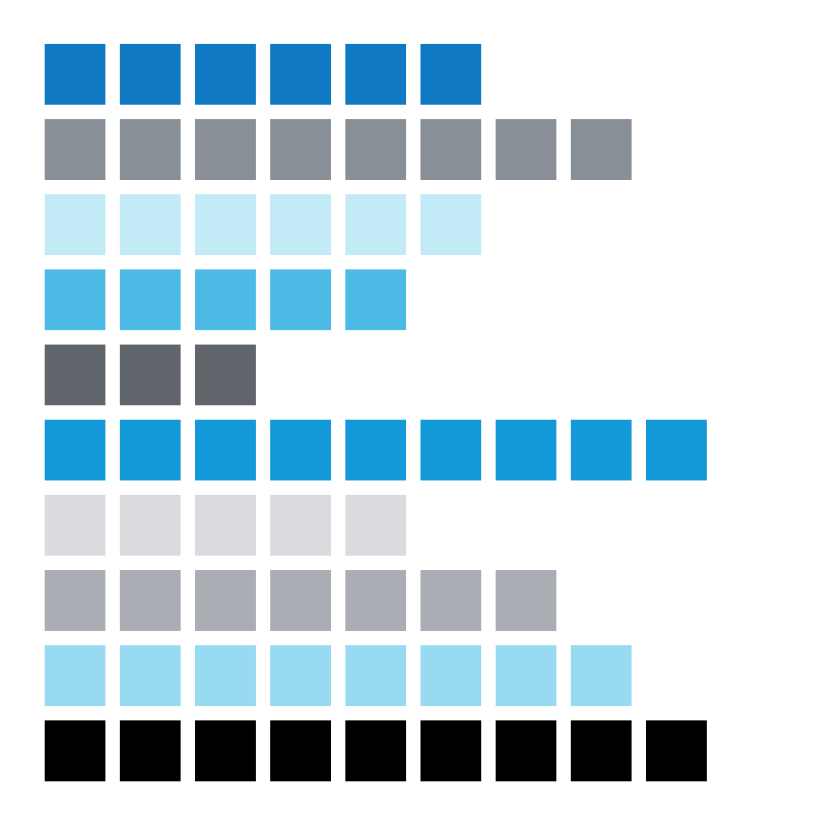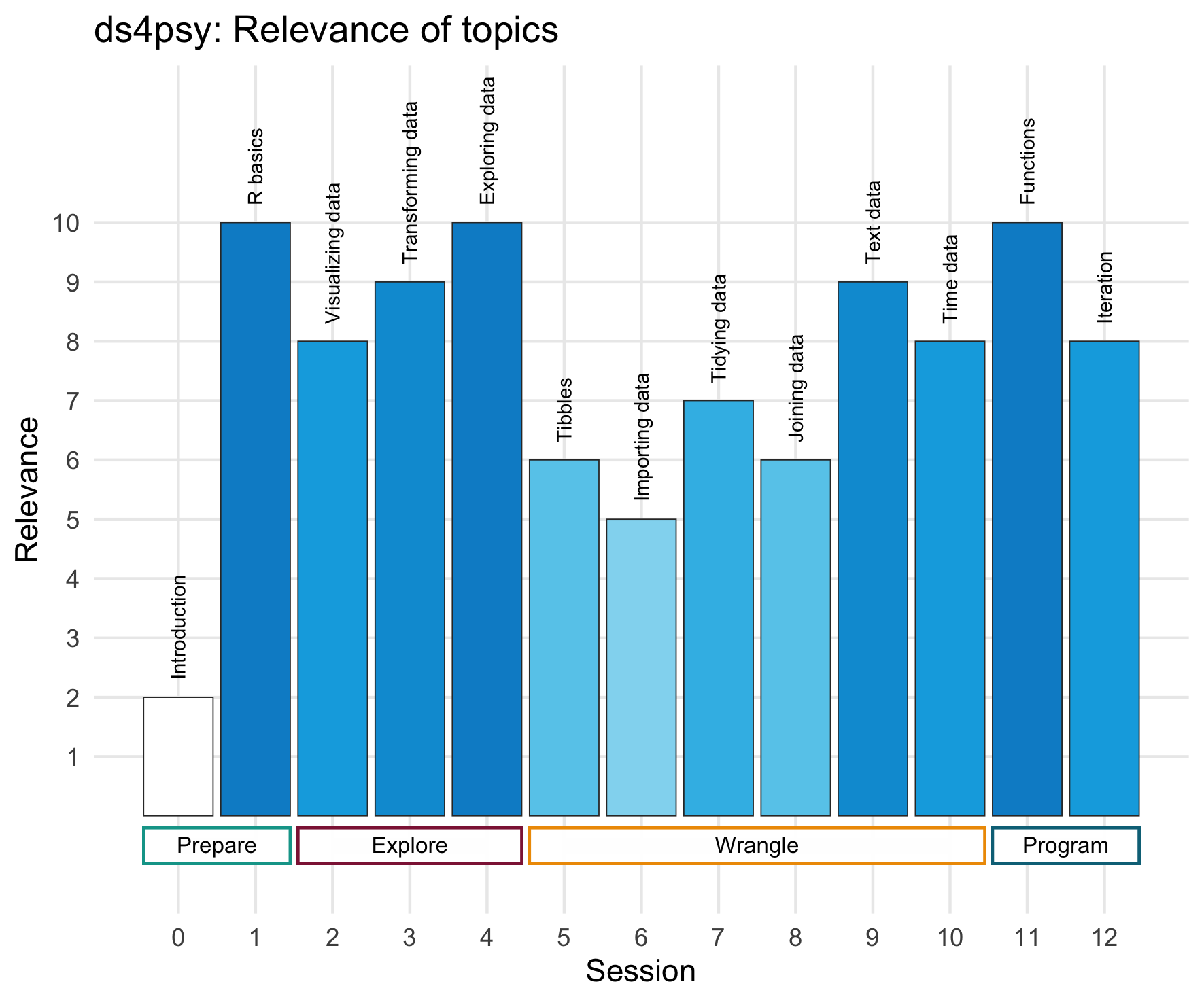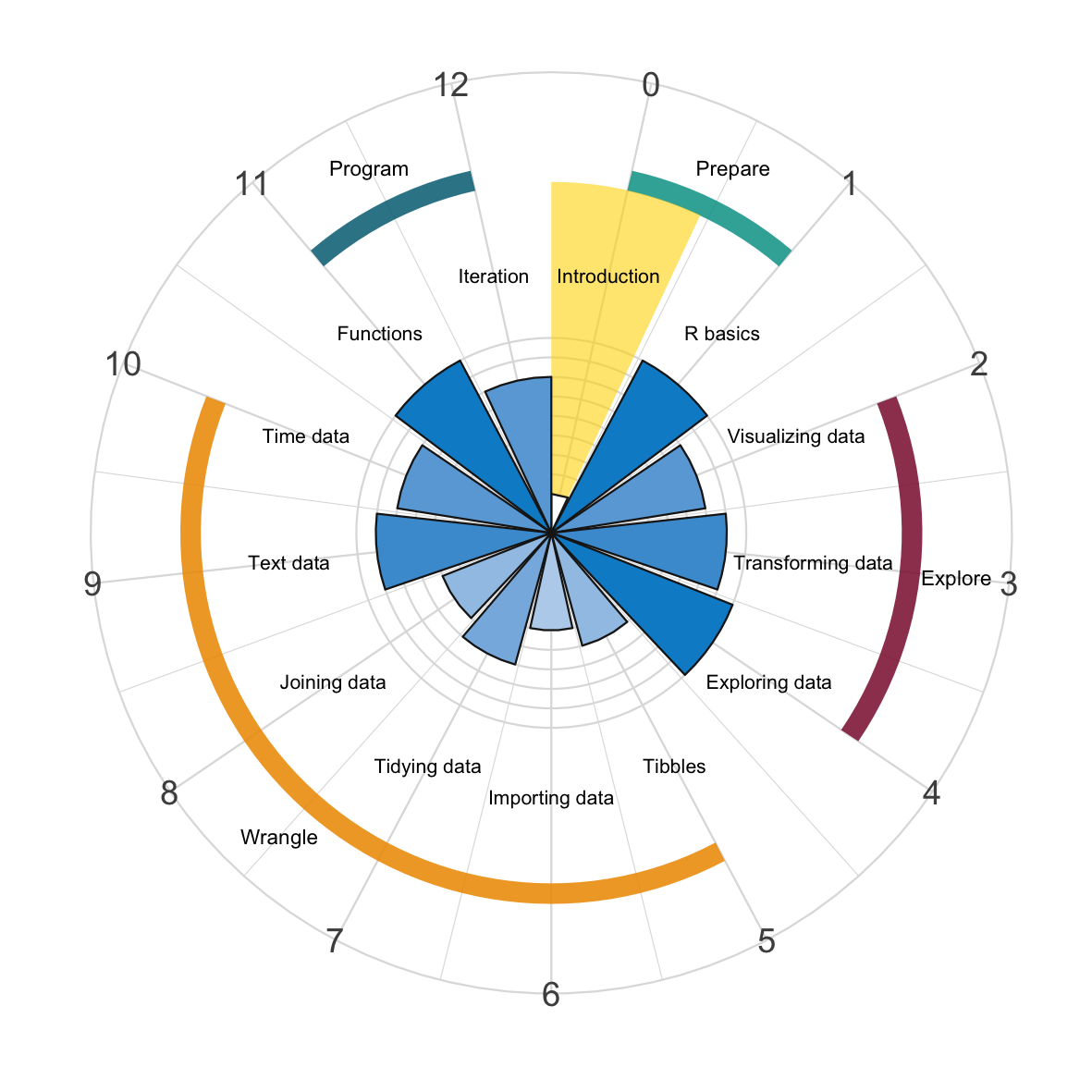Overview
Which tasks do we tackle where? The book is structured into four main parts and some appendices that cover special topics. Here is an overview of its chapters, with links to corresponding chapters in the r4ds textbook (Wickham & Grolemund, 2017):
Chapters and topics

Part 1: Prepare
- Preambulations
- ds4psy: Introduction (i.e., this chapter)
- r4ds: Chapters 1 & 2.
- Basic R concepts and commands
- ds4psy: Chapter 1 with exercises (Section 1.8)
- r4ds: Chapters 4/6/8.
- ds4psy: Chapter 1 with exercises (Section 1.8)
Part 2: Explore
- Visualizing data
- ds4psy: Chapter 2 with exercises (Section 2.7)
- r4ds: Chapter 3: Data visualisation (ggplot2).
- ds4psy: Chapter 2 with exercises (Section 2.7)
- Transforming data
- ds4psy: Chapter 3 with exercises (Section 3.5)
- r4ds: Chapter 5: Data transformation (dplyr).
- ds4psy: Chapter 3 with exercises (Section 3.5)
- Exploring data
- ds4psy: Chapter 4 with exercises (Section 4.4)
- r4ds: Chapter 7: Exploratory data analysis (EDA) (dplyr & ggplot2).
- ds4psy: Chapter 4 with exercises (Section 4.4)
Part 3: Wrangle
- Tibbles
- ds4psy: Chapter 5 with exercises (Section 5.4).
- r4ds: Chapter 10: Tibbles (tibble).
- ds4psy: Chapter 5 with exercises (Section 5.4).
- Importing data
- ds4psy: Chapter 6 with exercises (Section 6.4).
- r4ds: Chapter 11: Data import (readr).
- ds4psy: Chapter 6 with exercises (Section 6.4).
- Tidying data
- ds4psy: Chapter 7 with exercises (Section 7.4).
- r4ds: Chapter 12: Tidy data (tidyr).
- ds4psy: Chapter 7 with exercises (Section 7.4).
- Joining data
- ds4psy: Chapter 8 with exercises (Section 8.4)
- r4ds: Chapter 13: Relational data (dplyr).
- Strings of text
- ds4psy: Chapter 9 with exercises (Section 9.7).
- r4ds: Chapter 14: Strings (stringr).
- ds4psy: Chapter 9 with exercises (Section 9.7).
- Dates and times
- ds4psy: Chapter 10 with exercises (Section 10.6).
- r4ds: Chapter 16: Dates and times (lubridate).
- ds4psy: Chapter 10 with exercises (Section 10.6).
Part 4: Program
- Functions
- ds4psy: Chapter 11 with exercises (Section 11.6).
- r4ds: Chapter 19: Functions.
- ds4psy: Chapter 11 with exercises (Section 11.6).
- Iteration
- ds4psy: Chapter 12 with exercises (Section 12.5).
- r4ds: Chapter 21: Iteration (loops and purrr).
- ds4psy: Chapter 12 with exercises (Section 12.5).
Appendices
The following appendices provide supporting materials for the ds4psy course:
Appendix A provides the solutions to exercises.
Appendix B provides details on the datasets used in this course.
Appendix C describes the features of a successful data science project.
Other appendices are of a more general nature and provide introductions to specific topics:
Orientation
The following diagram provides a schematic overview of the book parts, topics, and corresponding chapters in our course curriculum. Whereas the colors of the horizontal lines signals which sessions belong to each part, the height of a bar reflects the relevance of each chapter within this course:

Figure 0.1: Relevance of chapters and topics, with colored lines indicating different parts.
As you can see, the first four chapters are particularly important. And as the contents of later chapters build and depend on earlier ones, please make sure that you really make a solid start in your endeavours.
Arranging the same information in a clock-wise fashion is a bit gimmicky, but allows signaling our current position (by highlighting it in yellow):

Figure 0.2: Centrality of topics (on polar coordinates) and highlighting the current chapter (0).
Both plots also show that mastering Chapters 1 to 4 (i.e., Parts 1: Prepare and 2: Explore) will put you in a very good position for succeeding in this course.
Session structure
This course mostly uses the so-called flipped classroom paradigm, in which students are solving exercises — individually or in small groups — with additional guidance by the instructor (see Wikipedia: flipped classroom for details). So what should you do when?

Before class: You need to prepare every session at home by
reading the current chapter, and
preparing an
.Ror.Rmdscript that includes all chapter code (without the exercises).
During class: Every session consists of two parts:
Asking questions (plenary): To start each weekly session, the instructor introduces the current topic and answers questions on main concepts or commands.
Begin with weekly exercises (in random dyads/triples): Copy exercises into your script and solve them in a way that you can discuss/share with other members of the class.
After class: Finish exercises at home and submit your solutions on Ilias by Friday of the same week (23:59).